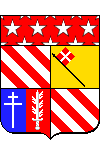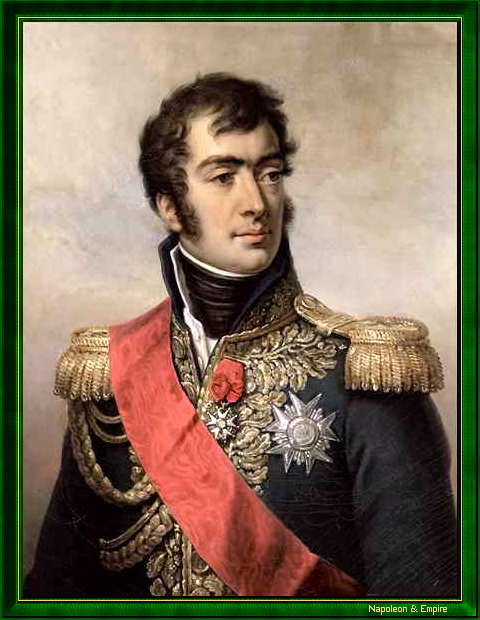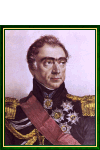Duke of Ragusa
Pronunciation:

The son of a nobleman officer, Auguste Frédéric Louis Viesse de Marmont was born on July 20, 1774 in Châtillon-sur-Seine, in Bourgogne (now the Deparment of Côte d'Or). His father intended him to become a magistrate, but the young Marmont preferred to join the army. He began his studies at the Collège de Châlons, where he met Jean-Andoche Junot, before attending the artillery academy in the same city.
He graduated in 1792 and was named Second Lieutenant in the 1st Artillery Foot Regiment. This was the same regiment where Napoleon Bonaparte had served six years earlier. Bonaparte noticed Marmont at the Siege of Toulon and quickly took him on as aide-de-camp, at first unofficially. The position was confirmed in February 1796 when they were moved to the Italian Army.
During the campaign, the young Marmont impressed his chief with his honesty, which was a rare commodity among a company of thieves and embezzlers.
In 1798 soon after his marriage with the daughter of the banker Jean-Frédéric Perregaux, Marmont left with the expedition to Egypt. He distinguished himself at Malta by capturing the flag of the Order of the Knights of Saint John (some suggest he bought it for five gold coins from his Sergeant). He was made a Brigadier General on the battlefield.
In Egypt, his premier achievement was to resist an English landing attempt as the Commander of Alexandria on February 2, 1799. He fought courageously in most of the battles of the campaign before returning with his chief to France on the frigate Muiron.
The role he played during the coup d'état of 18 Brumaire (November 9, 1799 in the French Republican Calendar), though secondary in nature, earned his the post of Councillor of State which he preferred over Artillery Commander in the Consular Guard, which would have put him under the command of Jean Lannes.
After failing to negotiate a loan from the Dutch, Marmont took part in the second Italian Campaign as Commander of the Reserve Artillery. His bravery at Marengo earned him a promotion to général de division (Major General) in September 1800.
He was Inspector General of the artillery in 1802 and Commander of the Utrecht camp in 1804, effectively commanding the French forces occupying Holland. He considered it an insult that he was not on the list of Marshals declared immediately after the creation of the Empire. This omission is explained by the fact that he had never engaged the enemy as a Commander-in-Chief.
In 1805, he commanded the 2nd Corps of the Grand Armée, crossing the Rhine on September 12. He was at Ulm on October 21 and occupied Leoben on November 12, but did not take any further part in the campaign. After Austerlitz, he occupied Graz before entering Friuli, where his embezzlement of funds annoyed Napoleon I but did not prevent him from being named Governor of Dalmatia on July 7, 1806.
Once again, he mismanagement of military funds earned him serious rebukes but did not negatively impact his career. On June 29, 1808, he was made Duke of Ragusa for having prevented a Russian fleet from lifting the siege of the city.
In 1809, Marmont again gave Napoleon I cause for displeasure for his passivity during the first few months of the war. Later, in command of the reserve at Wagram, he clumsily pursued the enemy after the battle, finally meeting them at Znojm almost by accident. Finding the enemy forces organized and ready for battle, he remained on the defensive while waiting for reinforcements, who soon arrived under the command of the Emperor. Under these conditions, the enemy demanded a cessation to the hostilities. This weak display of military prowess earned Marmont the title of Marshal the next day on July 12, 1809. This new distinction did nothing to satiate his ambition and high option of himself, especially as he watched Louis-Alexandre Berthier, Louis-Nicolas Davout and André Masséna rise to the rank of Prince.
After a sojourn in the Illyrian provinces, he received command of the Army in Portugal and Spain in May 1811 replacing Masséna. The Iberian campaign opened with a victory at Cuidad Rodrigo (September 24) that allowed him to invade Portugal where he faced Wellington. Injured and severely beaten at the Battle of Salamanca on July 22, 1812, he left Spain soon after only a few days before the English entered Madrid.
Once again, the criticism he received did nothing to alter the Emperor's confidence and trust in him.
On January 9, 1813, Marmont took command of the 1st Observation Corps on the Rhine. He was involved in all the major battles in Saxony: he commanded the left flank at Leipzig (October 16-19) where Michel Ney saved him on the third day when he found himself in a very difficult situation. The laurels enjoyed by the Prince of the Moskova only made him more bitter.
During the French Campaign, he commanded the 6th Corps of the Champagne Army and fought at Brienne (January 29, 1814), La Rothière (February 1), Champaubert (February 10), and Montmirail (February 11). Along with Adolphe Mortier, he was tasked with containing Blücher but he was disastrously beaten at Laon (March 9-10) despite his tactical abilities and blamed the defeat on the poor decisions of his colleague. He lost the final confrontations around Paris and negotiated the capitulation along with Mortier and Joseph Bonaparte before retreating to Normandy with his troops on April 4.
In march 1815, as a Peer and Knight of Saint Louis, Marmont accompanied Louis XVIII to Ghent as Commander of his military house. During the second Restoration, he voted in favour of the death of Ney before becoming Minister of State on November 30, 1817 and Governor of Paris between 1821 and 1830. In his post, he failed to put down the insurrection in July 1830 and left France with Charles X never to return.
He died, solitary and forgotten, from apoplexy in the Palazzo Loredan in Venise on March 3, 1852. He is buried in the Saint-Vorles Cemetary in Châtillon-sur-Seine in the Côte d'Or.
"Marshal Marmont, Duke of Ragusa" by Jean-Baptiste Paulin-Guérin (Toulon 1783 - Paris 1855).

Napoleon I always considered him a traitor or his capitulation at the gates of Paris and even more so for removing his troops to Normandy. Although it is doubtful that the several thousand men under Marmont's command - without considering the countless deserters - would have been capable of returning to battle to chase the Allies from Paris. This illusion left Napoleon convinced that he had not been defeated, but instead betrayed.
Other portraits

Enlarge
"General Marmont, year 1". French school of the nineteenth century.

Enlarge
"Marshal Marmont, Duke of Ragusa". Engraving of the nineteenth century